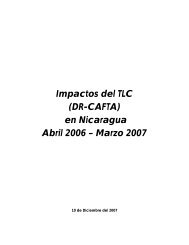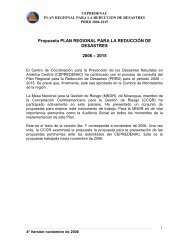A Gendered Analysis of the Social Protection Network in ... - CISAS
A Gendered Analysis of the Social Protection Network in ... - CISAS
A Gendered Analysis of the Social Protection Network in ... - CISAS
Create successful ePaper yourself
Turn your PDF publications into a flip-book with our unique Google optimized e-Paper software.
important potentially negative consequence. The results suggest that targets could be<br />
reached <strong>in</strong> a more ‘cost effective’ manner, that is that <strong>the</strong> f<strong>in</strong>ancial <strong>in</strong>centives <strong>of</strong>fered to<br />
improve take up <strong>of</strong> education and health services dur<strong>in</strong>g phase II could be less than<br />
those <strong>of</strong>fered dur<strong>in</strong>g phase I (see BID 2003 for discussion).<br />
In particular <strong>the</strong> high up take <strong>of</strong> vacc<strong>in</strong>ation programmes has led BID to conclude that<br />
<strong>the</strong> food grant <strong>of</strong>fered as an <strong>in</strong>centive <strong>in</strong> this case, can be cut and <strong>in</strong> <strong>the</strong> second phase <strong>the</strong><br />
amount <strong>of</strong>fered will be reduced each year. Similarly dur<strong>in</strong>g <strong>the</strong> next three-year phase it is<br />
<strong>in</strong>tended to gradually cut back <strong>the</strong> amounts <strong>of</strong>fered to some participat<strong>in</strong>g families to<br />
evaluate <strong>the</strong> impact <strong>of</strong> such measures <strong>in</strong> terms <strong>of</strong> behaviour change. That is <strong>the</strong> extreme<br />
poor are to be used as ‘gu<strong>in</strong>ea pigs’ to explore how few resources can be <strong>of</strong>fered for <strong>the</strong><br />
same ga<strong>in</strong>s.<br />
The <strong>in</strong>dicators used to evaluate <strong>the</strong> impact <strong>of</strong> <strong>the</strong> first phase <strong>of</strong> <strong>the</strong> RPS will be<br />
supplemented by o<strong>the</strong>r <strong>in</strong>dicators <strong>in</strong> <strong>the</strong> second phase, most notably <strong>the</strong> <strong>in</strong>clusion <strong>of</strong><br />
‘well be<strong>in</strong>g’ <strong>in</strong>dicators <strong>in</strong>clud<strong>in</strong>g: employment and <strong>in</strong>come sources, possession <strong>of</strong><br />
productive assets and variations <strong>in</strong> <strong>the</strong> price <strong>of</strong> basic products. However as to how <strong>the</strong><br />
RPS is to have a direct, or even <strong>in</strong>direct impact on <strong>the</strong>se elements over <strong>the</strong> three years <strong>of</strong><br />
implementation is far from clear.<br />
An evaluation <strong>of</strong> <strong>the</strong> impact <strong>of</strong> <strong>the</strong> RPS on those on whom its success depends- women<br />
- is not contemplated.<br />
Conclusions<br />
The RPS can be critiqued from a number <strong>of</strong> positions. Most fundamentally, <strong>the</strong><br />
provision <strong>of</strong> food, money and o<strong>the</strong>r services to <strong>the</strong> most vulnerable does not tackle <strong>the</strong><br />
causes <strong>of</strong> that vulnerability and any change that is brought about is unsusta<strong>in</strong>able. It is<br />
also a relative exercise <strong>in</strong> that <strong>the</strong> <strong>in</strong>creases <strong>in</strong> annual <strong>in</strong>come for those families <strong>in</strong><br />
extreme poverty <strong>in</strong>cluded <strong>in</strong> <strong>the</strong> RPS will only be sufficient to move <strong>the</strong>m over <strong>the</strong><br />
extreme poverty l<strong>in</strong>e and <strong>in</strong>to general poverty.<br />
Tak<strong>in</strong>g <strong>in</strong>to account <strong>the</strong> wider poverty context <strong>in</strong> which <strong>the</strong> RPS is be<strong>in</strong>g implemented,<br />
and <strong>the</strong> multidimensionality <strong>of</strong> poverty, <strong>the</strong> RPS appears not only narrow <strong>in</strong> its<br />
implementation, but also narrow <strong>in</strong> its orientation. Only a small proportion <strong>of</strong> those<br />
liv<strong>in</strong>g <strong>in</strong> extreme poverty will benefit from <strong>the</strong> programme and with<strong>in</strong> this group<br />
children under five years <strong>of</strong> age are prioritised. While <strong>the</strong> PRSP highlights <strong>the</strong> need for<br />
‘special protection’ to be afforded to children under five years <strong>of</strong> age, it also notes <strong>the</strong><br />
existence and need <strong>of</strong> o<strong>the</strong>r particularly vulnerable groups, such as ‘abused women’ <strong>the</strong><br />
disabled and <strong>the</strong> aged. The RPS makes no mention <strong>of</strong> <strong>the</strong>se groups.<br />
More generally what narrow programmes such as <strong>the</strong> RPS do not take <strong>in</strong>to account is not<br />
only that <strong>the</strong> well be<strong>in</strong>g on an <strong>in</strong>dividual is multi-dimensional, but that one <strong>in</strong>dividual’s<br />
well be<strong>in</strong>g may be related to that <strong>of</strong> ano<strong>the</strong>r person – <strong>in</strong> particular that <strong>the</strong> health and<br />
well be<strong>in</strong>g <strong>of</strong> children may be <strong>in</strong>tegrally l<strong>in</strong>ked to that <strong>of</strong> <strong>the</strong>ir parents.<br />
This be<strong>in</strong>g said, <strong>the</strong> RPS is a good example <strong>of</strong> how <strong>in</strong>clusion can be as problematic as<br />
exclusion. Women are targeted with<strong>in</strong> <strong>the</strong> RPS as <strong>the</strong> means by which resources will be<br />
delivered to children. Not only does <strong>the</strong> RPS re<strong>in</strong>force exist<strong>in</strong>g gender stereotypes but it<br />
also imposes costs on women that have not been recognised nor <strong>in</strong>cluded when<br />
12



